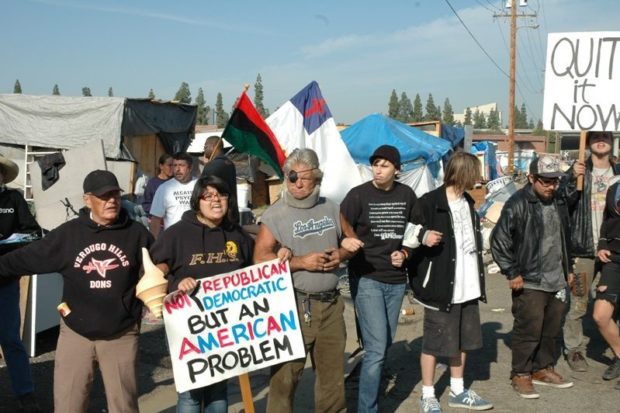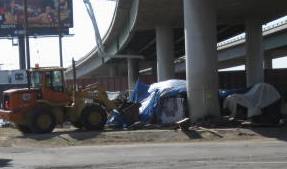
By Mike Rhodes
Two days after the final assault on homeless encampments by the City of Fresno and Caltrans, Rose and her daughter were trying to find someplace where they could sleep. When I found them, they were under a bridge, being told by three Fresno police officers to move on. Rose asked, “Move where?” One officer replied that they needed to move somewhere out of sight. “We tried that the last several nights and you idiots wake us up every two hours and tell us to move on.”
Rose went down a list of places they had been chased out of. The officers shuffled their feet, looked at the ground and said, almost apologetically, that they had orders to keep Rose and other homeless people from returning to any of the encampments that the City had just destroyed.
Two days before the incident with Rose a California Highway Patrol officer, observing the destruction of the homeless encampment on G Street known as The Hill, told me that all these evictions would accomplish was that people would be displaced. “They don’t have anywhere to go and this is not the answer,” he said as we watched a bulldozer plow through the encampment, destroying tents, beds and what little the homeless had to keep them warm and out of the rain. 
The massive eviction of the homeless started on Oct. 27 at the Santa Fe encampment, south of Ventura Street in downtown Fresno. The City has wanted to eliminate that encampment for a long time.
Until a couple of months ago, many of the shelters at the camp were occupied by men on parole who are classified as sexual offenders (290s). According to numerous sources, many of the 290s had been dropped off and told to live at this homeless encampment by their parole agents. There are so few houses and apartments available that comply with current laws that 290s were being forced to live in the Santa Fe homeless encampment.
Being homeless is one of the biggest predictors of recidivism for sexual offenders. Having them at the encampment was not good for them or the community. It is hard to imagine that forcing them to disperse into other parts of the community, while still homeless, is going to improve the situation.
After the 290s were gone, the City and Caltrans posted eviction notices for all of the remaining residents, many of whom had built shelters with framed walls, pitched roofs and foundations. There were also lots of tents. It was a regular little shantytown, much like what you would normally see in a third world country.

When the City and Caltrans showed up to destroy the encampment, there were more than 100 community supporters of the homeless who showed up to protest the eviction. Protesters were able to prevent the City from starting the evictions on time and held them off at the south end of the encampment for about an hour. Protesters and the homeless linked arms and prevented garbage trucks and a sanitation department crew from entering the camp.
As the day progressed, Caltrans and the City managed to start clearing out the camp. By the end of the day, all but a couple of structures were still standing. Supporters of the homeless expressed concerns about the destruction of homeless people’s property as the evictions took place. In a 2006 settlement with the City of Fresno and Caltrans, it was agreed that any property of value found during “cleanups” at homeless encampments would be put into storage for 90 days. There were clearly tents, beds and other property destroyed on Santa Clara, in apparent violation of the federal court order.
The settlement agreement reads: Paragraph I A (3) “the City of Fresno shall not destroy any materials of apparent value which appears to be the personal property of any individual. Personal property may include clothing, shoes, jackets, tents, sleeping bags, bed rolls, back packs, duffel bags, bicycles, tools, watches, jewelry, audio and video equipment, medications, toiletries, eyeglasses, purses, handbags, personal papers, equipment, photographs, books and baby strollers.”
Paragraph I A (4) provides “the fact that property is unattended does not necessarily mean that it has been discarded. Reasonable doubt about whether property is ‘trash or debris’ or valuable property should be resolved in favor of the conclusion that the property is valuable and has not been discarded.” 
The complete settlement document can be seen at http://www.aclunc.org/cases/closed_cases/asset_upload_file890_8469.pdf. In short, the settlement requires the City and Caltrans to treat homeless people’s property like any other property they might find. If the police find your bike on a street corner, they do not send for a bulldozer to pick it up, put it into the back of a garbage truck and immediately destroy it. The process for how the City and the state handle property has to be consistent, whether you are a millionaire or you are homeless.
Homeless advocates took photos and video of the destruction of property on Santa Fe in the hope that it will be useful to defend homeless people’s civil rights, should legal action be necessary. They also visited the other encampments, taking photos of people with their property, helping them make signs to ID items like tents, and getting contact information from them about how they could be found after the evictions.
 Laynette Johnson put her name on the shelter where she lived, on H Street under the Monterrey bridge. She knew there were signs posted warning of an eviction on Nov. 1, but she had to attend classes at Cesar Chavez Continuation School that day. Bill Simon, chair of the Bishop John Steinbock Homeless Advocacy Committee, was there and told Caltrans workers that Laynette was at school and that they should not destroy her property. It was not abandoned.
Laynette Johnson put her name on the shelter where she lived, on H Street under the Monterrey bridge. She knew there were signs posted warning of an eviction on Nov. 1, but she had to attend classes at Cesar Chavez Continuation School that day. Bill Simon, chair of the Bishop John Steinbock Homeless Advocacy Committee, was there and told Caltrans workers that Laynette was at school and that they should not destroy her property. It was not abandoned.
Simon described what happened next: “The bulldozer would use its bucket to smash the tent and other structures with their contents, then run over it and finally dump everything in a dump truck. Everything she had except four plastic trash bags of small items was bulldozed. Every tent/structure with belongings that I could see north of her on H Street was similarly bulldozed.” Video of the destruction, which appears to be a clear violation of the federal court order, is available, should legal action be taken.

On Nov. 2, the City “cleanup” moved to the homeless encampments on G Street, where some confusion occurred after Caltrans posted signs giving the residents more time to move. The City moved onto G Street destroying shelters that were identified as someone’s personal property and tagged by Caltrans as being safe from destruction until Nov. 7.
Even without such obvious confusion, the eviction of the homeless from all of the encampments in downtown Fresno came at a bad time. With the weather getting colder, rain starting to fall and the holidays upon us, most of the homeless who were dislocated have nowhere to go and can now be seen wandering all over downtown, pushing shopping carts (with what little they could save) from one place to another.
The City has declared this a victory. They can now say that they have ended the blight of all of the homeless encampments and are working to find homeless people housing.
In a statement sent to the media, Gregory Barfield, the City’s homeless prevention and policy manager, was quoted as saying that “the City and its partners are devoting a tremendous amount of resources to finding long-term solutions to our homelessness issue. We’re in the midst of a methodical process that involves collecting many documents and matching the needs of individuals with the resources available in the community, but the reality is that we’re all working together and making progress in getting these homeless individuals the help they need.”

The City’s press release also cited construction projects that necessitated the removal of the homeless encampments, even though several of the encampments were nowhere near those construction projects. Two years ago, when the City insisted that it had to shut down the H Street encampment, it said that a construction project was eminent. The City evicted the homeless, put up a fence with razor wire around it and then no construction project ever took place. If you ask homeless people why they are cynical about the motivation of the city, you are reminded about incidents like this.
Homeless advocates, who spoke at an Oct. 26 press conference at City Hall, argue that the homeless encampments should not have been destroyed, unless there was a better place for people to go. Homeless advocate Simon said that “as a temporary solution, we must provide safe camps with trash bins and water and porta-potties for the homeless.” Simon said he thinks there are 25,000 homeless people in Fresno, with at least 5,000 of those sleeping on the streets.
In its press statement, the City said it could help find up to 140 people housing as a result of the evictions that took place. Homeless advocates, like Simon, wonder what will happen to single women and other vulnerable people who no longer have neighbors that can help look out for them. How is forcing homeless women to live under an oleander bush by the highway, where they are isolated and more vulnerable to predators, going to help the homeless?
District 3 City Council Member Oliver Baines has encouraged homeless advocates in the progressive community to develop a plan for safe and legal homeless encampments that include basic public services. Baines said that if he is comfortable with the proposal, he will take it to his colleagues for consideration. If adopted, that would resolve a serious gap in city policy regarding the homeless.
Homeless advocates, who have sometimes been identified by government officials as wanting to maintain and promote shantytowns instead of ending homelessness, say they want affordable and decent housing for everyone. But the reality is that homelessness will not end immediately and that until everyone has housing, a better midterm solution needs to be found. That is why these advocates are promoting the development of safe and legal camps where homeless people can live with dignity and respect until they get into permanent housing.
*****
Mike Rhodes is the editor of the Community Alliance newspaper. Contact him at editor@fresnoalliance.com. To see photos, video, and articles about homelessness in Fresno over the past nine years, visit https://fresnoalliance.com/?p=1313.
